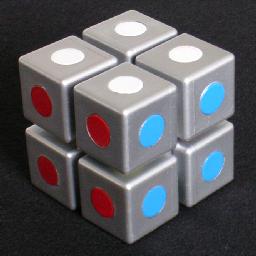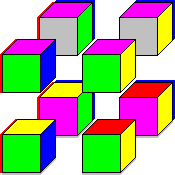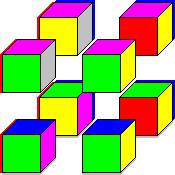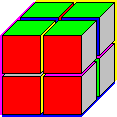Octacube, as the name implies, consists of eight cubes. The eight cubes all have the
same 6 colours on their faces, though they are all arranged differently. The aim is
to build a 2×2×2 cube, so that every side of the larger cube has only
one colour, and so that faces that touch each other match in colour.
There are two versions of this puzzle. The version pictured above has metallic cubes,
with a magnetic square slab between them to keep them in place. There is a cheaper
version with black plastic cubes held together by a square frame.
The colour arrangements of the eight cubes are shown below, in no particular order.
My thanks to Puzzlemaniac for giving me this puzzle.
The number of positions:
The cubes can be arranged in 8! different orders, each cube has 24 orientations, giving a
maximum of 8!·248 positions. The solved puzzle as a whole has 24 possible
orientations, so there are really only 8!·247 = 184,926,527,815,680
distinct positions. There are two solutions however.
Solution:
The first solution:
The second solution:
The colour arrangement on the cubes is quite clever. Consider the following cube:
Suppose you had 8 of the cubes above, stacked in a larger 2×2×2 cube so that the
larger cube has the same colour arrangement on the outside, which matches that of the two
Octacube solutions. The touching internal faces of these identical cubes obviously do not
match in colour. Suppose that on four non-adjacent cubes (for example the top front right
and back left cubes and the bottom front left and back right cubes) you cycle around the
colours on their three internal faces in one direction, and on the remaining four cubes you
cycle their three hidden colours in the other direction. This will cause the touching faces
to match colour.
The procedure above produces one solution. If you had cycled all the hidden faces in the
other direction, then you get the other solution. It turns out these are the only
solutions, though this is not obvious.
I will now describe a quick method to find the solution.
-
Choose a colour, say blue. Place the cubes in a widely spaced row with the blue face on the bottom.
-
There is one colour that does not occur on any top face, i.e. which does not occur
opposite blue. This is probably green. Turn all the cubes so that green is at the back
(and blue remains at the bottom).
-
There are four colours that occur on the top faces, each on two cubes.
Put the cubes with the same top colour next to each other, making four pairs of cubes.
Make sure that in each pair the touching faces match in colour. If they don't, then swap
the two cubes.
-
There are four pairs. Two pairs have red and yellow on the front, and the other
two pairs have purple and white on the front. Put together the pairs that have the same
front colours, so you have two 1×1×4 blocks. The touching faces will
automatically match in colour.
-
In one of the 1×1×4 blocks, split it in half, turn one half upside down and
place the other half on top to make a 1×2×2 block. The touching faces are all
blue.
In the other 1×1×4 block, take the left and the right cubes, and place
them back to front behind the middle cubes, making a 1×2×2 block. The new
touching faces here are mostly green.
-
Put the two 1×2×2 blocks together to form the solved 2×2×2 cube.











